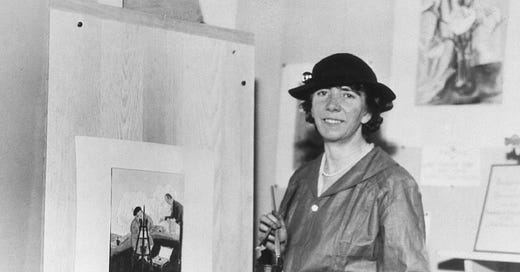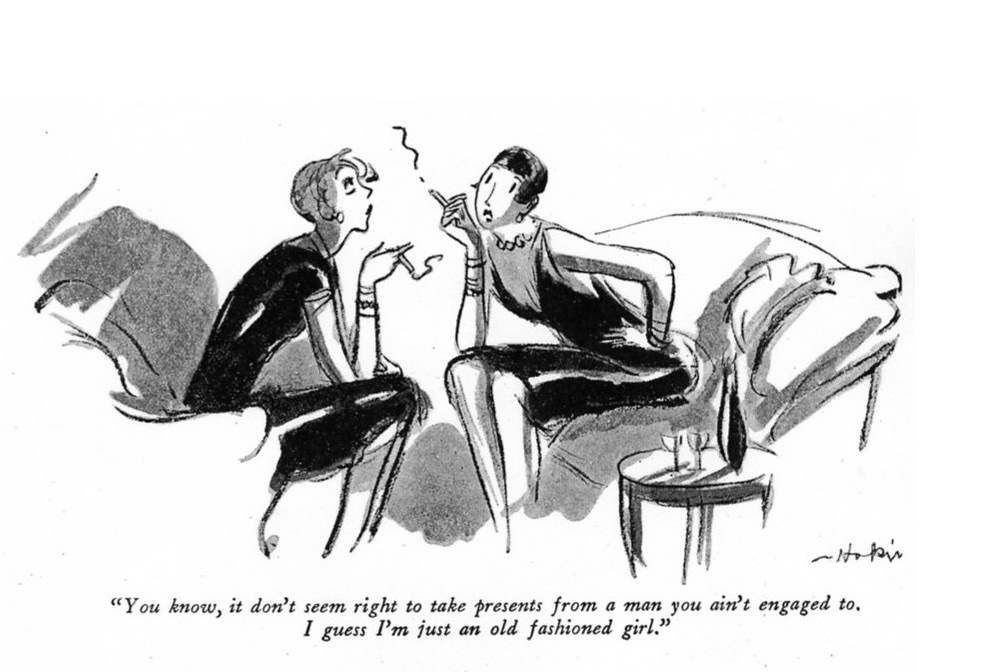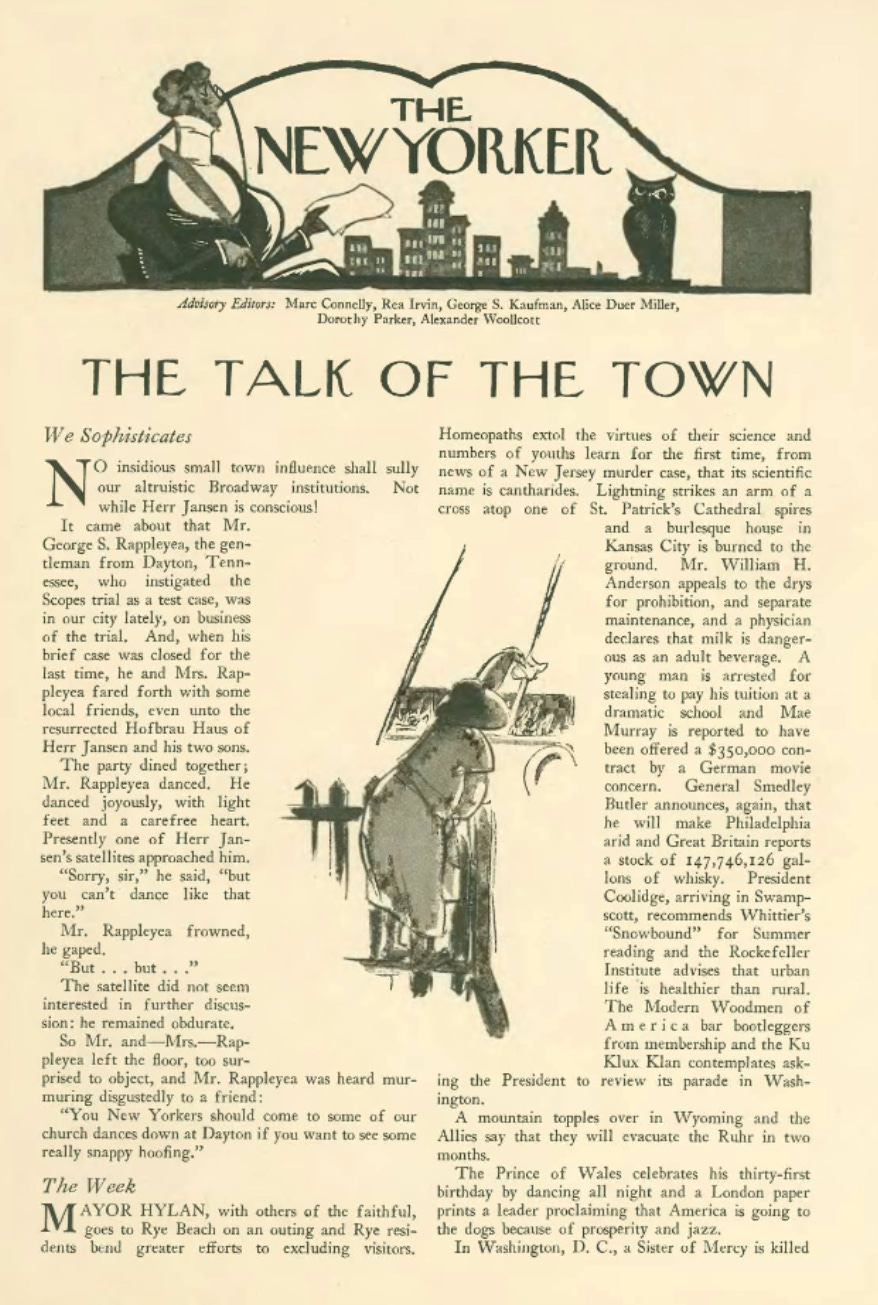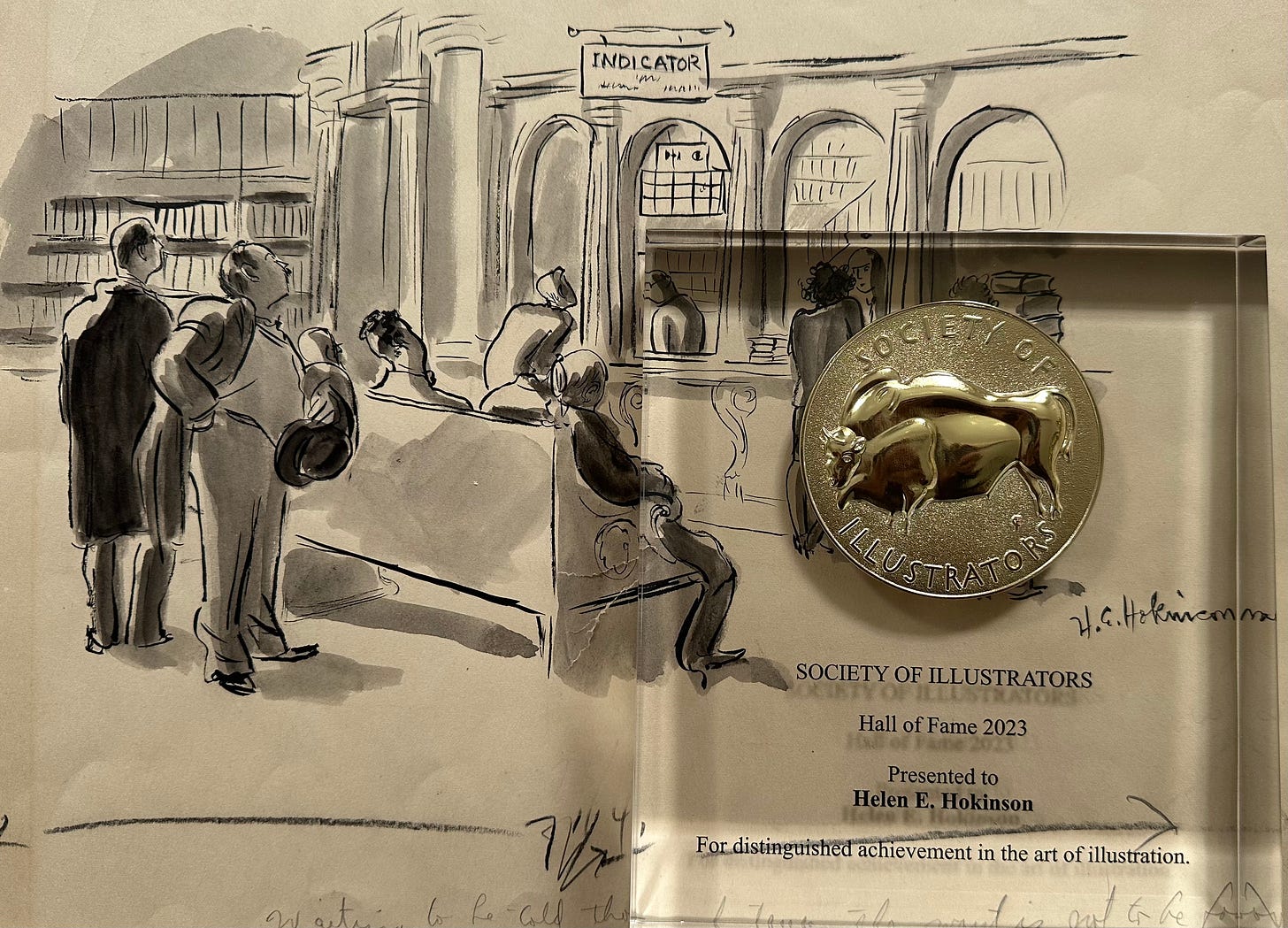The Society Of Illustrators Inducts New Yorker Cartoonist Helen Hokinson Into Their Hall of Fame
I was honored to accept the award on her behalf
Yesterday, New Yorker cartoonist Helen Hokinson was inducted into the Hall of Fame at the Society of Illustrators in New York City. My husband, cartoonist Michael Maslin, and I attended the lively celebration along with many wonderful artists we know. Michael wrote about it here, in his blog Inkspill.
Since she had no living relatives, the Society of Illustrators asked if I would accept the award for her, and of course I said yes. It was a great honor.
I have written about Ms. Hokinson over the years, in my book and in essays for The New Yorker and elsewhere. She was a wonderful artist, and a groundbreaker, starting in the magazine in 1925 as one of very few women.
Here below is the lucite award, placed in front of one of her drawings (an illustration done at the NY Public Library for The New Yorker) that we own.
It really was an incredible honor, the Society of Illustrators, also known as the Museum of Illustration, was founded in 1901 and has a long storied history of artists and illustrators as members, including Norman Rockwell and NC Wyeth. It is the oldest museum in the country dedicated to the art of illustration. Below are the remarks I made last night as I accepted the award on her behalf. There was a catalogue for the evening that contained an essay I wrote about her, which gives more history, so I decided my remarks should be more personal observation.
I am deeply honored to accept this award for Helen Hokinson. After spending decades studying and writing about her, I am deeply grateful to be here. What little I know of her as a person, I imagine she would be overwhelmed and self-effacing about this, yet grateful to be acknowledged by her peers.
Helen was a wonderful artist. You’ve read about her so I don’t need to add much except perhaps some personal reflections.
Like so many of her colleagues, Helen was classically trained. She drew beautifully, with great skill and artistry. To me, what made her so different is this: her line organically had humor in it. She helped us see people, yet she infused her line with her point of view. She gave us a feeling of humor through her pen.
Helen shared her ideas in her choices of what she drew. She had observational skills that set her apart. She loved to wander around NYC drawing people, and many of those became cartoons, or full-spread series in The New Yorker.
She helped us see ourselves in others.
I wonder if she knew how groundbreaking she was, being one of a few women working as a cartoonist at the fledgling humor magazine. Helen was from a small town outside of Chicago (Mendota: I spent a few days there on my book tour, and was welcomed with open arms. They are so proud of her). In the early 1920’s, she bravely made her way to NYC as a young woman during a time when that was not easily done.
What is it about some people, they have a vision for themselves, a desire to do something and won’t take no for an answer! And when I say “no” I mean society was telling her not to do this. Women aren’t funny, they said!
She was one of those people. She was a determined young woman, and very very funny
These are the people who help bring change, one by one. By creating a career for herself and sharing her beautiful work, she emboldened other women I’m sure, and she emboldened me. She drew what it was like to be a woman in New York City in the 1920’s and 30’s, providing a window for us into that world. Humor can show us a reality in nuanced ways.
How difficult was it for her? What kind of internal struggles did she daily manage? Editor Harold Ross was her champion, that was extremely important and worth noting. The letters between them are caring and teasing, primarily Helen teasing Ross. When she discovered that Peter Arno was being paid more per cartoon than she was, she complained and Ross fixed the problem.
But I can only imagine the cultural pressure to conform, to not stay true to yourself.
If you look closely at her later work, you can perhaps see those pressures as she tried to adapt to post-war America. Her early work at The New Yorker reflected different aspects of life, but later, her drawings and covers primarily showcased the matronly, heavy set middle aged ladies. Helen is quoted that she adored those characters, saying “I love my ladies- I wouldn’t do anything they wouldn’t do.” Those ladies showed resilience, curiosity, and a lack of fear.
With the shifting of the culture, Helen began to think that her audience was laughing AT her ladies and not WITH them. In 1949 she decided to go on a speaking tour to explain these characters to her audience. On the first leg of that tour, she was killed in a plane crash. I often wonder if she had lived, how would she have navigated the new world of the 1950’s in her drawings? What would she show us about women’s lives?
How would she have helped us laugh?
I am extremely grateful that Helen pushed through to become the success that she did. It’s a tragedy that she died so young; but she left her mark: a body of wonderful work. Helen used her pen line to show us women’s lives and to make us laugh.
It’s so wonderful that the society is honoring her tonight, thank you for letting me be a part of it.
Happy Sunday! Thanks for being here.












One of my favorite Hokinsons shows her little Scottie with her at a recruiting office, was it, volunteering the dog’s services because he’s good “at crawling under things.” Hope I’m not mangling this. The tenderness in her line! And you addressed this so beautifully in your acceptance speec. Cheers to two funny ladies! 🎉 (And I have your valuable book.) Love Michael’s tribute, too.
Fascinating! And she was hilarious! I like how you've displayed her award... I'm sure she's thrilled, where-e'er she is. ❤️